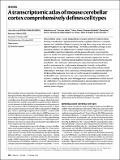| dc.contributor.author | Kozareva, Velina | |
| dc.contributor.author | Martin, Caroline | |
| dc.contributor.author | Osorno, Tomas | |
| dc.contributor.author | Rudolph, Stephanie | |
| dc.contributor.author | Guo, Chong | |
| dc.contributor.author | Vanderburg, Charles | |
| dc.contributor.author | Nadaf, Naeem | |
| dc.contributor.author | Regev, Aviv | |
| dc.contributor.author | Regehr, Wade G | |
| dc.contributor.author | Macosko, Evan | |
| dc.date.accessioned | 2023-01-13T13:59:43Z | |
| dc.date.available | 2023-01-13T13:59:43Z | |
| dc.date.issued | 2021 | |
| dc.identifier.uri | https://hdl.handle.net/1721.1/147092 | |
| dc.description.abstract | <jats:title>Abstract</jats:title><jats:p>The cerebellar cortex is a well-studied brain structure with diverse roles in motor learning, coordination, cognition and autonomic regulation. However, a complete inventory of cerebellar cell types is currently lacking. Here, using recent advances in high-throughput transcriptional profiling<jats:sup>1–3</jats:sup>, we molecularly define cell types across individual lobules of the adult mouse cerebellum. Purkinje neurons showed considerable regional specialization, with the greatest diversity occurring in the posterior lobules. For several types of cerebellar interneuron, the molecular variation within each type was more continuous, rather than discrete. In particular, for the unipolar brush cells—an interneuron population previously subdivided into discrete populations—the continuous variation in gene expression was associated with a graded continuum of electrophysiological properties. Notably, we found that molecular layer interneurons were composed of two molecularly and functionally distinct types. Both types show a continuum of morphological variation through the thickness of the molecular layer, but electrophysiological recordings revealed marked differences between the two types in spontaneous firing, excitability and electrical coupling. Together, these findings provide a comprehensive cellular atlas of the cerebellar cortex, and outline a methodological and conceptual framework for the integration of molecular, morphological and physiological ontologies for defining brain cell types.</jats:p> | en_US |
| dc.language.iso | en | |
| dc.publisher | Springer Science and Business Media LLC | en_US |
| dc.relation.isversionof | 10.1038/S41586-021-03220-Z | en_US |
| dc.rights | Creative Commons Attribution 4.0 International license | en_US |
| dc.rights.uri | https://creativecommons.org/licenses/by/4.0/ | en_US |
| dc.source | Nature | en_US |
| dc.title | A transcriptomic atlas of mouse cerebellar cortex comprehensively defines cell types | en_US |
| dc.type | Article | en_US |
| dc.identifier.citation | Kozareva, Velina, Martin, Caroline, Osorno, Tomas, Rudolph, Stephanie, Guo, Chong et al. 2021. "A transcriptomic atlas of mouse cerebellar cortex comprehensively defines cell types." Nature, 598 (7879). | |
| dc.contributor.department | Massachusetts Institute of Technology. Department of Biology | en_US |
| dc.relation.journal | Nature | en_US |
| dc.eprint.version | Final published version | en_US |
| dc.type.uri | http://purl.org/eprint/type/JournalArticle | en_US |
| eprint.status | http://purl.org/eprint/status/PeerReviewed | en_US |
| dc.date.updated | 2023-01-13T13:52:20Z | |
| dspace.orderedauthors | Kozareva, V; Martin, C; Osorno, T; Rudolph, S; Guo, C; Vanderburg, C; Nadaf, N; Regev, A; Regehr, WG; Macosko, E | en_US |
| dspace.date.submission | 2023-01-13T13:52:33Z | |
| mit.journal.volume | 598 | en_US |
| mit.journal.issue | 7879 | en_US |
| mit.license | PUBLISHER_CC | |
| mit.metadata.status | Authority Work and Publication Information Needed | en_US |
